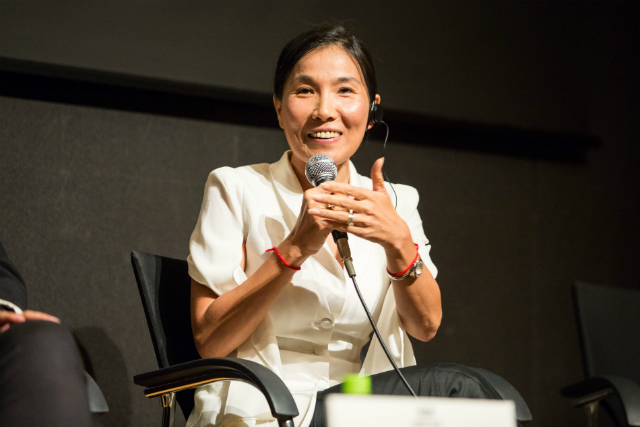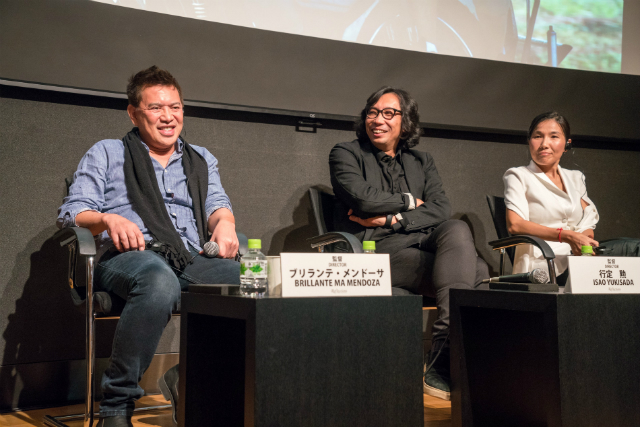The Trust that Binds the Three Films
Ishizaka: Let's open the panel to the floor.
Question 1 : Mr. Mendoza spoke about using small devices and how each member of crew smoothly cross over into each other's turfs during filming. My friends and I also make film in a similar way, but, Mr. Mendoza and Mr. Yukisada, could you tell us the advantages or disadvantages of this kind of method?
Mendoza: I'm giving workshops to young filmmakers and my advice to them is, "be resourceful and flexible." The harder you think, the more difficult filmmaking can get. So I tell them to always be resourceful in making film. Your motivations are important, but so is your knowledge; to be a good filmmaker requires you to have many different ideas, to know your plot, and to be well-acquainted with many of the equipment. And this is true especially for the younger generations of filmmakers. There were times where older-generation directors only had to direct. But that is not the case now. Now, I think younger filmmakers have to learn many things, multitask, and be resourceful when making film.
Yukisada: In Japan, the landscape is still like that of the older generation. There is a clear hierarchy: the director doesn't run around; s/he is, say, the conductor in the orchestra. Each member clearly knows what their roles are, it is compartmentalized, and they each do their part. That's why preparation is essential. In Asia - I felt this in China, Korea, and Malaysia - they do some preparation but the rest is improvised. When you need something - a location-change, different props, or whatever it is - as long you have it at the moment you shoot, you're good. It all evolves. And what is really impressive is their motivation to understand what the director is trying to achieve. In Japan, each of the crew members has their own interpretations which the director tries to sort out. I've been raised in Japanese filmmaking like that, but filming in Asia-especially in Malaysia this time - I felt that the style Dante and his crew have is the best; my cinematographer and I were saying throughout the shoot, "Let's try to do it with just five or so members. We need to teach these things to Japanese filmmakers too." They're all professional, so they must be able to do it.

In Japan, we also have a problem with filming permits: you cannot shoot without them. When foreigners are shooting on the streets in Shibuya with lights and everything, it's fine. But as soon as a Japanese film crew does that, they'll be shut down. In Asia, we can do that. Watching Dante's film, I realized that he was consistent in his style even in Japan: those scenes in the airport or inside the plane, for instance. I asked him, "how did you do that?" and he said, "I just did" [smiles]. But you can capture reality far better that way. Sometimes you end up in the frame too but that's ok. But that flexibility, that grittiness, is very inspiring. Entering more into the digital age, I think our styles will evolve more that resemble theirs.
Question 2 : I was able to relate to all three films despite each of their historical differences - as if they were joined together like kintsugi. *2 You each had leitmotifs, I think, for your films - horses, pigeons, and the bridge - but could you each share with us your thoughts behind them?
*2 Said to have begun in the Muromachi period (c. 1336-1573), kintsugi or kintsukuroi is the Japanese art of reparing cracked or damaged pottery using lacquer dusted or mixed with gold, silver, or platinum powder or pigment.
Kulikar : Phnom Phen is divided into two by a river [the Tonle Sap River], and I was on the other side of it during my childhood. There was a bridge but it was destroyed back then, so we had to get on a boat to cross the river. When I was nine years old, my mother took me on one to the other side of the city, and I remember being very scared if there were crocodiles around, if a storm came, or our boat would capsize. Especially because both my mother and I couldn't swim. Every time we crossed on the boat, we'd pass under that bridge, and, looking up at it, I once asked my mother, "Why is this bridge broken?" And she told me then it is called the "Japanese Bridge" that symbolized friendship between the two countries.

Without the bridge, we had to cross by boat or go around so it was very inconvenient. But when the bridge was repaired in 1994, I went there to celebrate with everyone, and, I think, that there was a sense of befriending there. The two sides of the city were connected. Not only that, I think this bridge connects the past and present and Cambodia and Japan. It symbolizes the repair or tie between all of these. For me, personally, it ties the past and present, me, my children, and my husband. Another element I'd like to mention is the kintsugi (kintsukuroi) that appears in this film. In the film, during dinner, Fukuda (Masaya Kato) describes an ochoshi [sake server] that has kintsugi: "If an object is broken and repaired, we often try to hide the cracks. With kintsukuroi the breakage and the repair are seen as a part of an object's history."

Kintsugi is an old craft in Japanese ceramics, but I think this represents a much-needed healing process for Cambodians. In Cambodia, when something breaks it is seen as inauspicious and is thrown away. It is the same with pasts that are sad: we either try to forget about it or hide it. But in Japan, with kintsugi, they beautifully repair the broken pottery with gold. That's when I thought we Cambodians can better understand our identities not by hiding our traumatic pasts but by embracing them. We must repair, like kinstugi, our broken pasts and through such a process, I think Cambodians can heal their pasts. Fukuda returns to Cambodia to repair the broken bridge; he reconnects the two sides. I think this resonates with kintsugi. Those are my ideas behind the "bridges" in the film.
Mendoza: For me, I've always been interested in Overseas Filipino Workers. That is something I do: make my interests a motif in my films. Last year, during my visit to Japan, I interviewed Filipinos working here, but I also spoke to those who'd returned to the Philippines from Japan. And that is how I came up with the story; by listening to these Overseas Workers.
Yukisada: Well, I think pigeons are a symbol of peace, not only in Japan but in other countries too. And initially my thought was "Why is that? Why do they symbolize peace?" Then I remembered that pigeons have homing instincts - I used to own a few homing pigeons when I was little. In pigeon racing, twenty thousand pigeons are set free to find a goal that is as far as 1,600 km away, and although the number is small - only 10 percent or even 5 percent of them - some of them do find their way back. And I think that devotion is truly amazing. The owners, too: they set their pigeons free because they believe in them; that they will come home. And I thought that could be made into a motif: that sense of trust, of believing in each other; of trusting people, animals, and your crew. In this occasion, it certainly constituted a large portion of the teamwork because we were shooting across the ocean: I had to trust the Malaysian crew otherwise we wouldn't get anything done. If I doubted them, they would doubt me too. So I put my whole trust in them; I decided to laugh it off even if I was disappointed in some way or another. But they delivered, perfectly. The pigeons didn't, I must say [laughs], but everything else worked out fine.

When proposed of this Asian Three-Fold Mirror project and to work in this trio - Mr. Mendoza who is already a veteran filmmaker who makes fantastic works, Ms. Kulikar who is a rising filmmaker, and myself from the hosting country - I thought about how we were going to build this partnership, and it was through trust. We'd have meetings and there'd be a sense of something connecting; a certain flow that kept us together. Moreover, there was a sense that all three narratives came around full circle, and while they seem to each depict a sad story, I think, there is also the wish to be connected to each other, to trust one another. That is my observation of Asian Three-Fold Mirror. So pigeons, in that sense, symbolizes that; the idea of trusting each other. My film was themed on that kind of positivity of trust and hope.
Ishizaka: Thank you, Mr. Mendoza, Mr. Yukisada, Ms. Kulikar, and Mr. Yeo. This truly is a rare and valuable occasion where directors join to produce an omnibus film in Asia, and I personally think that there is still much to discover. As I said earlier, we are planning to showcase this omnibus not only in Japan but overseas too, so I hope you all have the chance to see it again. Thank you again to the panelists and to you all for joining us today.
The Auditorium, Roppongi Academyhills
October 27, 2017
Interviewer: Kenji Ishizaka
Ishizaka began researching and critiquing Asian and documentary films after majoring film study at Waseda University's Graduate School. He planned and managed approximately seventy Asia Middle-East Film Festival Series from 1990 through 2007 for the Japan Foundation. He has been a Programming Director of TIFF since its 20th in 2007, and he also holds the position of the professor of Japan Institute of Moving Image. He also wrote several books including Amidst the Sea of Documentary: Dialogues with Tsuchimoto Noriaki, published by Gendai Shokan.
Translator (Japanese-English): Meiko Sano (The Japan Foundation Asia Center)
Editor: Izumi Kakeya (The Japan Foundation Asia Center)
Photo (Symposium): Motoi Sato







